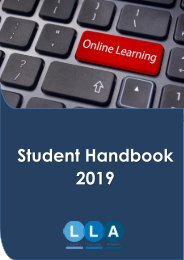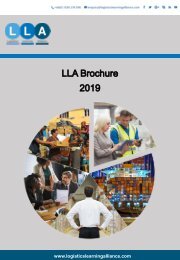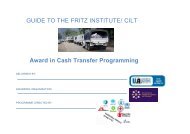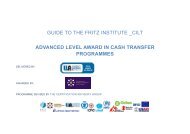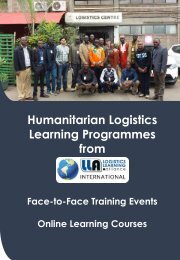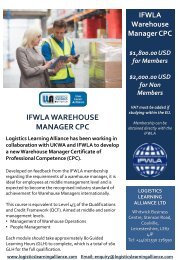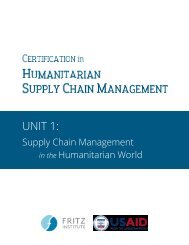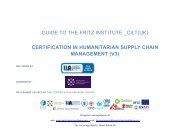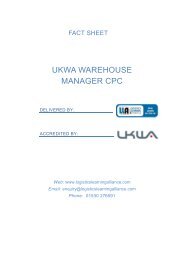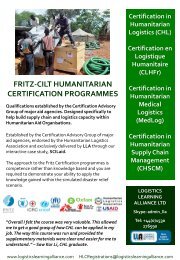CHL Guide V3 - September 2017
Certification in Humanitarian Logistics (CHL) Version 3 - Starts 1st September 2017.
Certification in Humanitarian Logistics (CHL) Version 3 - Starts 1st September 2017.
Create successful ePaper yourself
Turn your PDF publications into a flip-book with our unique Google optimized e-Paper software.
GUIDE TO THE FRITZ INSTITUTE/ CILT(UK)<br />
CERTIFICATION IN HUMANITARIAN<br />
LOGISTICS (<strong>V3</strong>)<br />
DELIVERED BY:<br />
AWARDING ORGANISATION:<br />
PROGRAMME DIRECTED BY:
GUIDE TO THE CERTIFICATION IN HUMANITARIAN LOGISTICS<br />
CONTENTS<br />
GUIDE TO THE CERTIFICATION IN HUMANITARIAN LOGISTICS .............................................................................................................. 2<br />
CONTENTS ........................................................................................................................ 2<br />
INTRODUCTION ................................................................................................................. 4<br />
LOGISTICS LEARNING ALLIANCE LTD ......................................................................... 4<br />
KEY FEATURES ................................................................................................................ 4<br />
TYPICAL CANDIDATE PROFILE ..................................................................................... 5<br />
THE CASE STUDY AND LEARNING SYSTEM ............................................................. 5<br />
THE ASSESSMENT PROCESS ........................................................................................ 6<br />
SCILAID CASE STUDY ..................................................................................................... 6<br />
COMPETENCY ................................................................................................................... 8<br />
ENROLMENT & FEE SCALE ........................................................................................... 9<br />
SUPPORT ........................................................................................................................... 9<br />
QUALIFICATION STRUCTURE ...................................................................................... 10<br />
©Logistics Learning Alliance Ltd<br />
web: www.logisticslearningalliance.com email: hlcregistrations@logisticslearningalliance.com<br />
Tel: +44 (0) 1530 832264<br />
Skype: Admin_lla
UNIT 1: Supply Chain in Humanitarian Aid ......................................................................................................................................................... 11<br />
UNIT 2: Warehousing & Inventory ...................................................................................................................................................................... 13<br />
UNIT 3: Procurement ......................................................................................................................................................................................... 15<br />
UNIT 4: Transport ............................................................................................................................................................................................... 17<br />
UNIT 5: Fleet Management ................................................................................................................................................................................ 19<br />
UNIT 6: Cash Transfer Programming (CTP)....................................................................................................................................................... 21<br />
UNIT 7: Managing a Humanitarian Supply Chain Response............................................................................................................................... 23<br />
©Logistics Learning Alliance Ltd<br />
web: www.logisticslearningalliance.com email: hlcregistrations@logisticslearningalliance.com<br />
Tel: +44 (0) 1530 832264<br />
Skype: Admin_lla
INTRODUCTION<br />
This guide provides background information to the Logistics Learning Alliance’s programme for the Fritz Institute/CILT(UK) Certification in<br />
Humanitarian Logistics (<strong>CHL</strong>). This programme is delivered only by supportive, distance learning and exclusively by LLA.<br />
We will allocate you a specialist coach who will guide and assist you to the conclusion of the qualification. The coach’s role is to ensure that<br />
you are able to access the required learning and then to steer you through its effective application in a real life operational setting.<br />
At the end of this programme we are confident that you will be equipped to apply the concepts in your chosen operation. We really look<br />
forward to working with you to help you realise the potential you clearly believe you have.<br />
LOGISTICS LEARNING ALLIANCE LTD<br />
The coaches at LLA have been involved with training people working in the supply chain and its related activities for many years.<br />
In the UK we are a CILT(UK) Approved Centre for the delivery of their qualifications, managing the learning programmes for many students<br />
who pursue their qualifications by distance learning.<br />
Our experience of working with a wide range of organisations gives us a good view of the challenges facing twenty first century supply<br />
chain management and this experience is reflected in the design and delivery of this certification programme.<br />
KEY FEATURES<br />
This certification programme is a practical work-based qualification which will equip students with a complete set of skills for operations in a<br />
humanitarian situation. The LLA competency route provides an opportunity for experienced practitioners to gain an internationally recognised<br />
qualification attesting to their competence in humanitarian logistics management.<br />
The candidate is required to demonstrate the practical application of the knowledge gained to situations which simulate those encountered in<br />
real life humanitarian operations.<br />
©Logistics Learning Alliance Ltd<br />
web: www.logisticslearningalliance.com email: hlcregistrations@logisticslearningalliance.com<br />
Tel: +44 (0) 1530 832264<br />
Skype: Admin_lla
TYPICAL CANDIDATE PROFILE<br />
A typical candidate will either be involved in humanitarian aid logistics at an operational level or considering entering the profession at this level.<br />
This programme is also relevant for those providing a range of support services to those operating in the field.<br />
THE CASE STUDY AND LEARNING SYSTEM<br />
Supported Self Study is attractive to logistics/supply chain practitioners as it easily fits into a pattern of life that often involves erratic<br />
working hours and transient working locations. Traditionally though it is a learning method with a downside. At times you can seem to be<br />
isolated with nowhere to turn to for support. This is not the case with this programme. From the outset of the programme, candidates are<br />
allocated a coach/tutor with specialist knowledge of the subject area. The coach will agree a personal learning plan for each unit with the<br />
candidate, designed to enable the candidate to complete their studies well within the timescale of 3 years allowed by the FI/CILT (UK).<br />
Typically, the programme should be finished in less than half of this time. The coach will support, advise, and guide the student through any<br />
areas of difficulty to the successful conclusion of the programme.<br />
The learning process includes a detailed case study that is a broad but intensive exploration of an NGO, SCILaid, involved in an on-going<br />
humanitarian aid operation. For the purposes of the study programme learners are „recruited‟ by SCILaid and appointed to a position relevant<br />
to their course of study. They will perform the tasks required by their role, demonstrating the necessary competences for the qualification.<br />
This is learning by challenge and application.<br />
Logistics Learning Alliance will provide new students with an internet link enabling them to download the case study simulation to their hard<br />
drive. The full download will include<br />
‣ A “ virtual‟ introductory tour of SCILaid<br />
‣ Access to statistical and operational information about the SCILaid environment<br />
‣ Access to management information which will provide information enabling the learner to submit work of an acceptable standard<br />
©Logistics Learning Alliance Ltd<br />
web: www.logisticslearningalliance.com email: hlcregistrations@logisticslearningalliance.com<br />
Tel: +44 (0) 1530 832264<br />
Skype: Admin_lla
THE ASSESSMENT PROCESS<br />
The assessment process is designed to test two things:<br />
‣ The knowledge of the individual<br />
‣ The ability of the individual to apply that knowledge<br />
SCILAID CASE STUDY<br />
The case study provides a network of integrated or inter-related work-based tasks to ensure that whatever level and position within the<br />
hierarchy of SCIL plc they are appointed to, candidates will have the opportunity to demonstrate their ability to apply the knowledge gained.<br />
©Logistics Learning Alliance Ltd<br />
web: www.logisticslearningalliance.com email: hlcregistrations@logisticslearningalliance.com<br />
Tel: +44 (0) 1530 832264<br />
Skype: Admin_lla
The assessment process will take into account prior learning, achievement and experience, which is appropriate to the requirements of the<br />
qualification.<br />
Each candidate is assigned a personal specialist coach/tutor, who will work with the candidate to provide the evidence to satisfy:<br />
‣ All the outcomes of effective performance<br />
‣ All the knowledge requirements of the qualification<br />
Evidence of performance will be assessed on an on-going basis by LLA and externally verified by the CILT(UK).<br />
In addition, to satisfy the requirements for the award of the Certification, an element of each qualification has to be assessed independently<br />
from the organisation providing the learning, in this case LLA. It has, therefore, been decided that each Certification candidate will submit an<br />
element of their course work which will be assessed by the CILT (UK). This project will be based on the final unit of the programme,<br />
“Managing a Humanitarian Supply Chain Response”. LLA will brief you on the arrangements for this independent assessment once the<br />
programme has started.<br />
The charge for the initial assessment of the project is included in the programme fee, but re- assessments may incur additional charges.<br />
When the CILT (UK) is satisfied that all the requirements of the qualification have been met the award of the Certification in Humanitarian<br />
Logistics will be made.<br />
A 3-year time limit for the completion of the programme is granted. Students wishing to complete the programme beyond this deadline must<br />
submit a written application to LLA but should note the following<br />
‣ No application will be accepted if 4 years or more have lapsed since the student's initial registration<br />
‣ Students will have to re-start the programme after the 4-year period and re-register with LLA/CILT<br />
‣ Alternatively, students can go through the normal APL procedure for units previously completed but should be aware that they<br />
may have to assemble a completely new portfolio.<br />
Please note that these time limits are the maximum allowed to complete the qualification. Candidates are strongly urged to attempt to complete<br />
their studies within a shorter timescale and can reasonably expect to complete the programme within 18 months.<br />
Where a candidate takes in excess of three years, the continued provision of administrative support, coaching and assessment will be at the<br />
discretion of LLA.<br />
©Logistics Learning Alliance Ltd<br />
web: www.logisticslearningalliance.com email: hlcregistrations@logisticslearningalliance.com<br />
Tel: +44 (0) 1530 832264<br />
Skype: Admin_lla
Where candidates exceed the three year timeframe for completion of the certification programme there may be a requirement to reassess<br />
elements of the work submitted to ensure currency with the current competences. In this circumstance additional assessment fees may be<br />
payable.<br />
COMPETENCY<br />
One of the difficulties many candidates have at the start of their learning programmes is in making the adjustment to a system whereby<br />
competence is assessed rather than knowledge being examined. For competence assessment, the coach/tutor is trying to find out, not just<br />
how much you know, but if you understand it sufficiently to apply it in real life. Unlike a teacher or college tutor he has no knowledge of<br />
your background, past attainments or experience. He can take nothing for granted, and in addition cannot be too specific in the advice he<br />
gives you at times, as this may give you the answer without the need to research it yourself and work it out from first principles. It is<br />
common for questions to be asked to clarify particular issues but once you have completed a few of the lessons you will see how the<br />
system works.<br />
Your coach/tutor will use a combination of directive and supportive behaviour to guide you through this process. This may be delivered face<br />
to face, via e-mail, or a blend of both. You will also be required to submit regular reports to your coach.<br />
One of the frequently asked questions is “How well am I doing?” The simple answer is that if you are passing the units and the coach is not<br />
seeking additional clarification from you, this indicates that you are doing all that is required to demonstrate the necessary competence as<br />
laid down by the awarding body, in this case CILT(UK). The degree of competence is not an issue as you have reached the level of<br />
attainment required. However, the coach will always give you feedback on your approach and ways in which you could have improved your<br />
response.<br />
If at any time you feel you need help or advice either on the course content or the questions being asked, please let us know. The team is<br />
here to help you and give you guidance. There may also be some difficulty in understanding the way we say things or in our understanding fully<br />
the problem you feel you have. If you are experiencing such difficulties please let us know as early as possible. It is essential to keep in touch<br />
and work with us.<br />
In the simulation scenario, your „line manager‟ will set you a series of tasks designed to enable you to demonstrate your underlying knowledge<br />
and understanding. Through a report, you will show and justify how, using this knowledge and understanding together with your own<br />
experience, you would respond to the task. The full course of study is then completed in this tried and tested „little and often‟ way enabling<br />
©Logistics Learning Alliance Ltd<br />
web: www.logisticslearningalliance.com email: hlcregistrations@logisticslearningalliance.com<br />
Tel: +44 (0) 1530 832264<br />
Skype: Admin_lla
the principles learned to be gradually integrated into your real life daily work plan. The method is enjoyable, practical and a genuine fasttrack<br />
route to an internationally recognised qualification.<br />
You will be taken through the steps of:<br />
‣ Analysing the current operational processes for a given scenario<br />
‣ Exploring the options for improvements<br />
‣ Defining the preferred solution<br />
‣ Showing how the solution should be implemented.<br />
On the completion of the tasks for the unit, you will have a completed portfolio of evidence of competence that your coach will refer for<br />
assessment by a qualified assessor. This may lead to a request for further evidence of your competence. In this eventuality, the candidate<br />
may have to re- visit one or two of the tasks and expand on or clarify work previously submitted. This will only happen if the final<br />
assessor disagrees with the assessment of the learner’s coach.<br />
On completion of the tasks, you will work on your project for independent assessment. Information on the project requirements will be<br />
issued separately.<br />
ENROLMENT & FEE SCALE<br />
No formal qualifications are required to enrol as a candidate for the Certification programme. The fees for this programme are available on<br />
application to Logistics Learning Alliance on<br />
SUPPORT<br />
+44 (0) 1530 832264 or HLCRegistrations@logisticslearningalliance.com<br />
Strong coaching support is built into all Logistics Learning Alliance learning programmes and candidates are encouraged to contact their coach<br />
whenever they need advice and guidance. Coaches are available by telephone during normal UK business hours (0900 to 1700 UK time) or by<br />
e-Mail. Experience has shown us that the most successful students are those who do not hesitate to contact their coach whenever they need<br />
support.<br />
©Logistics Learning Alliance Ltd<br />
web: www.logisticslearningalliance.com email: hlcregistrations@logisticslearningalliance.com<br />
Tel: +44 (0) 1530 832264<br />
Skype: Admin_lla
QUALIFICATION STRUCTURE<br />
The Certification in Humanitarian Logistics programme has been modelled on a competency framework which specifies precisely what a<br />
humanitarian logistician should be able to do and how well it should be done. To achieve the Certification, candidates are required to<br />
demonstrate competence in a variety of area, which will include:<br />
‣ Humanitarian Supply Chains<br />
‣ Warehouse and Inventory<br />
‣ Procurement<br />
‣ Transport<br />
‣ Fleet Management<br />
‣ Cash Transfer Programmes<br />
‣ Managing the Humanitarian Supply Chain Response<br />
The contents of the Units are detailed in annex A<br />
©Logistics Learning Alliance Ltd<br />
web: www.logisticslearningalliance.com email: hlcregistrations@logisticslearningalliance.com<br />
Tel: +44 (0) 1530 832264<br />
Skype: Admin_lla
ANNEX A – <strong>CHL</strong> STRUCTURE<br />
UNIT 1: SUPPLY CHAIN IN HUMANITARIAN AID<br />
OBJECTIVE:<br />
LEARNING OUTCOMES<br />
The learner can…<br />
PROVIDE AN OVERVIEW OF THE WORLD OF HUMANITARIAN AID AND THE<br />
IMPORTANCE AND ROLE OF SUPPLY CHAINS AND LOGISTICS AND UNDERSTAND THE<br />
DIFFERENT REQUIREMENTS FROM SUPPLY CHAIN/LOGISTICS FOR THE VARIOUS<br />
MODALITIES OF AID.<br />
ASSESSMENT CRITERIA<br />
The learner will…<br />
1. Identify situations and places in the • Define humanitarian aid and identify potential situations in<br />
world where humanitarian aid is which it is used<br />
required and the types (modalities) of • Identify aid modalities and their respective benefits<br />
aid given<br />
• Identify the operational constraints connected to humanitarian<br />
aid situations<br />
2. Identify the objectives, activities, and<br />
partners of humanitarian aid<br />
organisations<br />
3. Explain the expertise and<br />
perspectives of each function in a<br />
humanitarian organisation<br />
4. Identify how logistics and supply<br />
chain supports different delivery<br />
mechanisms and beneficiary service<br />
programmes<br />
• Identify the types of organisations involved in humanitarian aid<br />
• Identify the operational requirements for working with<br />
humanitarian organisations<br />
• Identify sources of funds and other resources used by<br />
humanitarian organisations<br />
• Identify opportunities for collaboration in the supply chains of<br />
relevant humanitarian agencies<br />
• Evaluate the operational constraints connected to the sources<br />
of funds and resources<br />
• Explain the contribution of logistics and supply chain<br />
management to the objectives of humanitarian organisations<br />
• Identify the need for operational relationships with other<br />
functions/activities within humanitarian organisations<br />
• Identify the obstacles and challenges to logistics and supply<br />
chain management in humanitarian organisations<br />
CONTENT<br />
• Definition of humanitarian aid<br />
• Different situations and reasons for humanitarian aid<br />
• Constraints in providing humanitarian aid<br />
• The different modalities and programme benefits of each<br />
• Types and mandates of organisations involved in humanitarian<br />
aid<br />
• Operational activities of humanitarian aid organisations<br />
• Phases of humanitarian response<br />
• Sources of funds and resources<br />
• The link between achieving programme objectives and delivery<br />
• What is meant by logistics, supply chain, and its main<br />
components<br />
• The role of supply chain and how it links with other aid activities<br />
and other functions in the organisation<br />
• The importance of the performance of the supply chain in aid<br />
situations<br />
• The Modality Decision – what it is, who makes it, and<br />
contributions from each function<br />
• Beneficiary service programmes<br />
• Identify types of beneficiary service programmes<br />
• Identify and estimate logistics requirements for different types of • Decision making for programme approach<br />
beneficiary service programmes<br />
• Specific logistics requirements of beneficiary service<br />
• Develop an action plan to coordinate logistics and supply chain programmes<br />
activities with other activities<br />
• Coordination with other functions/activities<br />
©Logistics Learning Alliance Ltd<br />
web: www.logisticslearningalliance.com email: hlcregistrations@logisticslearningalliance.com<br />
Tel: +44 (0) 1530 832264<br />
Skype: Admin_lla
ANNEX A – <strong>CHL</strong> STRUCTURE<br />
5. Explain how logistics/supply chain<br />
contributes to the modality decision<br />
and each phase of the project cycle<br />
6. Explain the difference between<br />
organisational policies and<br />
compliance and the value of standard<br />
operating procedures (SOPs)<br />
7. Identify preparedness actions for a<br />
humanitarian aid supply chain<br />
8. Identify actions that will contribute to<br />
the improvement of a humanitarian<br />
aid supply chain<br />
• Identify the phases of the project cycle<br />
• Identify logistics/supply chain activities / contributions during<br />
each phase of the project cycle<br />
• Explain the difference between organisational policies, donor<br />
requirements, and compliance<br />
• Explain standard operating procedures and how they support<br />
segregation of duties<br />
• Explain link between sources of resources and restrictions on<br />
usage<br />
• The phases of the project cycle<br />
• Major activities / tasks in each phase<br />
• Logistics / supply chain contributions to achieving successful<br />
implementation of each phase<br />
• Ethics<br />
• Organisational policies<br />
• Donor requirements<br />
• Compliance<br />
• Segregation of duties<br />
• Standard operating procedures<br />
• Sources of resources<br />
• Identify key parts of humanitarian supply chains and their • Preparedness vs contingency planning<br />
characteristics for various aid situations<br />
• Supply chain preparedness<br />
• Explain the planning process for a humanitarian supply chain • Communication infrastructure and information systems<br />
• Identify resource requirements for a humanitarian supply chain • Human resources needed<br />
• Identify key relationships for an effective and efficient • Important relationships<br />
humanitarian supply chain<br />
• Identify components of an implementation plan to achieve<br />
supply chain requirements<br />
• Identify potential improvements<br />
• Develop implementation plan for improvements<br />
• Monitor impact to performance and cost and provide feedback<br />
on implemented improvements<br />
• How to measure and analyse supply chain performance,<br />
including KPIs for both performance and cost<br />
• Why supply chains may not always function effectively and<br />
efficiently in humanitarian aid organisations<br />
• Improvement opportunities in humanitarian supply chains<br />
• Analysing the way supply chain has contributed to the overall<br />
relief programme<br />
©Logistics Learning Alliance Ltd<br />
web: www.logisticslearningalliance.com email: hlcregistrations@logisticslearningalliance.com<br />
Tel: +44 (0) 1530 832264<br />
Skype: Admin_lla
ANNEX A – <strong>CHL</strong> STRUCTURE<br />
UNIT 2: WAREHOUSING & INVENTORY<br />
OBJECTIVE:<br />
BUILD THE SKILLS AND KNOWLEDGE REQUIRED FOR COMPETENCE IN<br />
WAREHOUSING AND INVENTORY MANAGEMENT FOR HUMANITARIAN<br />
ORGANISATIONS.<br />
LEARNING OUTCOMES<br />
The learner can…<br />
1. Explain the purpose of warehouses<br />
and inventory management<br />
2. Develop a plan to set up a new<br />
warehouse<br />
3. Develop a plan to manage<br />
warehouse operations<br />
ASSESSMENT CRITERIA<br />
The learner will…<br />
• Compare existing warehouse and inventory management<br />
systems and procedures with organisation policy<br />
• Identify potential improvements and develop implementation<br />
plan<br />
• Identify information required for a warehouse and inventory<br />
management plans and strategy<br />
• Develop a warehouse and inventory management plans and<br />
strategy<br />
• Create a warehouse layout<br />
• Define appropriate warehouse processes<br />
• Evaluate and select appropriate warehouse resources<br />
• Evaluate and select appropriate handling and storage<br />
equipment<br />
• Analyse and interpret supply and demand data<br />
• Identify the regulatory and security requirements of a<br />
warehouse<br />
• Plan for receipt and storage of in-bound goods, order picking,<br />
and dispatch operations<br />
• Allocate resources (labour and other) on a daily basis in relation<br />
to this plan<br />
• Modify planned activity to cope with contingencies that may<br />
arise<br />
• Analyze performance of the warehouse operation<br />
CONTENT<br />
• The role of a warehouse in a humanitarian supply chain<br />
• The role of inventory in a humanitarian supply chain<br />
• The role of warehouse management<br />
• The role of inventory management<br />
• Understand need and use of warehouses in humanitarian<br />
supply chains<br />
• Characteristics and requirements of goods<br />
• Warehouse layouts<br />
• Processes, procedures, and resources<br />
• Handling and storage equipment<br />
• Other equipment<br />
• Use of supply chain data<br />
• Legislation and security<br />
• Plan warehouse receiving, storing, order assembly, and<br />
dispatch operations<br />
• Organize warehouse receiving, storing, order assembly, and<br />
dispatch operations<br />
• Control warehouse receiving, storing, order assembly, and<br />
dispatch operations<br />
©Logistics Learning Alliance Ltd<br />
web: www.logisticslearningalliance.com email: hlcregistrations@logisticslearningalliance.com<br />
Tel: +44 (0) 1530 832264<br />
Skype: Admin_lla
ANNEX A – <strong>CHL</strong> STRUCTURE<br />
4. Develop policies to manage inventory • Define demand capture operations<br />
• Forecast demand for goods<br />
• Analyze product availability and lead times<br />
• Define process for monitoring stock movements<br />
• Define process for auditing stock levels and stock inventories<br />
• Explain how to update, analyze, verify, and reconcile stock<br />
records<br />
5. Develop a plan to manage the work<br />
environment<br />
6. Define warehouse resource<br />
requirements and appropriate care<br />
• Identify health and safety concerns and requirements<br />
• Define controls for the safe and efficient receipt, storage,<br />
picking, and dispatch of goods<br />
• Develop a plan to manage security risks<br />
• Define policy for regular checking and servicing of equipment<br />
• Capture and forecast demand for goods and services<br />
• Stock control and movements<br />
• Stock levels<br />
• Stock records<br />
• Health and safety requirements<br />
• Security factors and risks that can affect warehouse operations<br />
• Plan and organize the care of warehouse equipment<br />
• Analyze data generated from the regular checking and servicing • Direct and control the care of warehouse equipment<br />
of warehousing equipment<br />
• Define reasons when equipment needs to be removed from the<br />
operation and the process for ensuring the right actions are<br />
taken<br />
©Logistics Learning Alliance Ltd<br />
web: www.logisticslearningalliance.com email: hlcregistrations@logisticslearningalliance.com<br />
Tel: +44 (0) 1530 832264<br />
Skype: Admin_lla
ANNEX A – <strong>CHL</strong> STRUCTURE<br />
UNIT 3: PROCUREMENT<br />
OBJECTIVE:<br />
BUILD SKILLS AND KNOWLEDGE REQUIRED FOR COMPETENCE IN PROCUREMENT<br />
AND IMPORT/EXPORT MANAGEMENT FOR HUMANITARIAN ORGANISATIONS.<br />
LEARNING OUTCOMES<br />
The learner can…<br />
ASSESSMENT CRITERIA<br />
The learner will…<br />
1. Explain the function of procurement • Identify logistics information requirements for the development<br />
of procurement plans and strategies<br />
• Identify opportunities for improvement of procurement<br />
operations<br />
2. Advise internal clients on orders • Explain order process and roles & responsibilities<br />
• Advise on development of specifications<br />
• Explain documentation requirements for import/export<br />
• Advise customers on specifications, cost, timings, etc., to<br />
enable them to prepare an order<br />
• Identify the appropriate INCOTERM for a specific import<br />
3. Develop a plan, systems, and<br />
processes for managing relationships<br />
with suppliers<br />
• Develop plan for building and managing effective working<br />
relationships with suppliers<br />
• Evaluate records of receipt and inspection of suppliers and<br />
performance records for services<br />
• Identify performance history from analysis reports and<br />
implement remedial actions<br />
• Define feedback mechanisms for information on supplier<br />
performance<br />
• Develop plan for working with suppliers to improve performance<br />
CONTENT<br />
• Definition of procurement<br />
• The difference between a partner and a supplier<br />
• The procurement process organisation<br />
• External relationships<br />
• Internal relationships<br />
Procurement vs. the ‘client unit’<br />
• Segregation of duties<br />
• Procurement planning<br />
• Information needed to prepare an order<br />
• How orders are processed<br />
• Sources of information for international trade<br />
• The use and application of INCOTERMS<br />
• Types of suppliers, service providers, and agents<br />
• Vendor rating<br />
• Supplier performance monitoring<br />
• Supplier development<br />
©Logistics Learning Alliance Ltd<br />
web: www.logisticslearningalliance.com email: hlcregistrations@logisticslearningalliance.com<br />
Tel: +44 (0) 1530 832264<br />
Skype: Admin_lla
ANNEX A – <strong>CHL</strong> STRUCTURE<br />
4. Evaluate sourcing options • Define requirements for goods and services<br />
• Evaluate supply market<br />
• Evaluate supplier capacity<br />
• Define supplier appraisal systems<br />
• Develop plan for implementing sourcing strategies<br />
• Complete analysis of import parity prices and make<br />
recommendation<br />
5. Apply purchasing policies and<br />
procedures<br />
6. Explain how to monitor and control<br />
inventory<br />
7. Illustrate effective management of<br />
risk<br />
• Assess use of appropriate procurement systems and<br />
procedures<br />
• Develop procurement plan for goods and services to be<br />
purchased<br />
• Explain process and inputs for the development of<br />
specifications<br />
• Produce appropriate documentation<br />
• Place order or contract according to procurement rules and<br />
procedures<br />
©Logistics Learning Alliance Ltd<br />
• Supply market analysis<br />
• Supplier appraisal<br />
• Sourcing strategies and supply sources<br />
• Commodity tracking<br />
• Import parity price analysis<br />
• Procurement systems and procedures<br />
• Procurement methods<br />
• Specifications<br />
• Supplier selection<br />
• Law of contract<br />
• Contractual arrangements<br />
• Contract and purchase/sales order administration<br />
• Explain how to operate and maintain an expediting system • Expediting<br />
• Explain how to process and monitor the requisition/order • Receipt and inspection<br />
• Compare deliveries against orders and maintain records of • Verifying and recording deliveries<br />
orders<br />
• Monitoring movement of goods<br />
• Explain how to monitor the progress of orders and goods<br />
through the delivery system using track and trace systems<br />
• Report on stock and upstream pipeline for inventory control and<br />
accurate reordering<br />
• Identify and explain how to manage critical goods and services<br />
• Identify risks and controls to manage them<br />
• Assess whether a code of ethics for procurement activity is<br />
being followed<br />
• Define a disciplinary/termination procedure in line with<br />
organisational rules and regulations<br />
• Explain methods of international payment and required<br />
documentation<br />
• Assess whether financial procedures are being followed and<br />
respected and make recommendations on how to adjust to<br />
meet requirements<br />
• Explain waivers of competition<br />
• Determine need for cargo insurance<br />
• Critical goods and services<br />
• Identify risks<br />
• Managing risks<br />
• Ethical procurement<br />
• Segregation of duties<br />
• Waivers of competition<br />
• Following financial procedures<br />
• Managing country and buyer risk<br />
• Bonds, guarantees, and indemnities in international trade<br />
• Main methods of international payment<br />
web: www.logisticslearningalliance.com email: hlcregistrations@logisticslearningalliance.com<br />
Tel: +44 (0) 1530 832264<br />
Skype: Admin_lla
ANNEX A – <strong>CHL</strong> STRUCTURE<br />
UNIT 4: TRANSPORT<br />
OBJECTIVE:<br />
BUILD SKILLS AND KNOWLEDGE REQUIRED FOR COMPETENCE IN TRANSPORT<br />
MANAGEMENT FOR HUMANITARIAN ORGANISATIONS.<br />
LEARNING OUTCOMES<br />
The learner can…<br />
ASSESSMENT CRITERIA<br />
The learner will…<br />
1. Define the goods to be moved • Compare the loads to type constraints and legislative controls<br />
• Select suitable handling methods for different consignments<br />
• Plan loads to match variable demand and supply<br />
2. Identify origins, destinations, & routes • Develop a plan and schedule freight transits for single and<br />
partial loads<br />
• Apply appropriate systems to audit current fleet performance,<br />
perform live order routing, prepare invoices, and audit<br />
contractors<br />
• Outline multi-modal routing relative to resources and time<br />
CONTENT<br />
• How characteristics of goods impact handling<br />
• Safety and security of goods to be moved<br />
• Unitization methods<br />
• Flows of good requiring movement<br />
• Sources and destinations of goods for movement<br />
• Collection and delivery site<br />
• Third parties<br />
• Route planning and scheduling<br />
3. Select appropriate modes of transport • Contribute to the Select an appropriate mode (or combination of • Suitability of various modes of freight transport for carriage of<br />
modes) for any specific goods movement and the appropriate goods<br />
vehicle within the mode<br />
• Vehicles of modes of transport<br />
• Plan movements through ports recognizing operational • Modal nodes<br />
characteristics<br />
• Characteristics of movement by rail<br />
• Plan movements by rail recognizing operational characteristics • Characteristics of movement by air<br />
• Plan movements by air recognizing operational characteristics • Characteristics of movement by road<br />
• Plan movements by road recognizing operational<br />
• Characteristics of movement by sea<br />
characteristics<br />
• Characteristics of movements by inland waterway<br />
• Plan movements by sea recognizing operational characteristics • Security precautions<br />
• Plan movements by inland waterway recognizing operational<br />
characteristics<br />
• Define security precautions necessary for freight interchanges,<br />
depots, terminals, and movements<br />
©Logistics Learning Alliance Ltd<br />
web: www.logisticslearningalliance.com email: hlcregistrations@logisticslearningalliance.com<br />
Tel: +44 (0) 1530 832264<br />
Skype: Admin_lla
ANNEX A – <strong>CHL</strong> STRUCTURE<br />
4. Develop a plan for movement of<br />
goods<br />
5. Develop a system for managing<br />
transport providers<br />
• Plan movement and international movements<br />
• Movement<br />
• Prepare a resource plan for the movement of goods<br />
• Issues involved in undertaking movements<br />
• Prepare a security plan for a journey<br />
• Planning movements<br />
• Establish need for import/export license requirements • Information exchange<br />
• Identify appropriate classifications of goods<br />
• Customs procedures<br />
• Explain customs procedures<br />
• Required documentation<br />
• Define documentation requirements<br />
• International classification of goods<br />
• Establish a process for monitoring movement of goods through • VAT regulations<br />
customs clearance<br />
• Select transport providers and establish contracts<br />
• Selecting transport providers<br />
• Develop a policy for managing the service provided by transport • Managing transport providers<br />
providers<br />
• Analyze performance data<br />
©Logistics Learning Alliance Ltd<br />
web: www.logisticslearningalliance.com email: hlcregistrations@logisticslearningalliance.com<br />
Tel: +44 (0) 1530 832264<br />
Skype: Admin_lla
ANNEX A – <strong>CHL</strong> STRUCTURE<br />
UNIT 5: FLEET MANAGEMENT<br />
OBJECTIVE:<br />
LEARNING OUTCOMES<br />
(The learner can…)<br />
1. Explain the function of fleet<br />
management<br />
BUILD SKILLS AND KNOWLEDGE REQUIRED FOR COMPETENCE IN FLEET<br />
MANAGEMENT IN A HUMANITARIAN ORGANISATION.<br />
ASSESSMENT CRITERIA<br />
(The learner will…)<br />
• Assess compliance of existing fleet management systems and<br />
procedures to organisational policies<br />
• Identify potential improvements in organisational fleet<br />
management systems and procedures and develop a plan for<br />
implementation<br />
• Identify information requirements for the development of<br />
organisational fleet management plans<br />
• Identify components of organisational fleet management plans<br />
2. Develop a plan to set up a fleet • Define the specifications of the requirements of the fleet<br />
• Identify relevant legislative and security requirements<br />
• Evaluate and select suitable vehicles and equipment<br />
• Evaluate and select suitable human resources<br />
• Establish operational systems and procedures<br />
• Establish a vehicle and driver performance management<br />
system<br />
• Establish maintenance systems and procedures<br />
• Evaluate fuel supplies and controls<br />
3. Develop systems to manage a fleet • Create consolidated requirements for movements of goods and<br />
people based on orders received<br />
• Prepare routing plans and schedules to meet orders for<br />
movement of goods and people<br />
• Evaluate compliance with the relevant local regulations<br />
governing transport<br />
• Analyze costs and performance and prepare management<br />
reports<br />
CONTENT<br />
• What is fleet management<br />
• Fleet management systems and procedures<br />
• Fleet management plans<br />
• Understand needs and use of fleet<br />
• Process for selecting suitable vehicles equipment and facilities<br />
• Establish operating procedures<br />
• Establish systems for measuring and monitoring performance of<br />
fleet<br />
• Establish maintenance procedures and systems<br />
• Managing documentation<br />
• Administration requirements<br />
• Managing drivers<br />
• Complying with relevant legislation and security requirements<br />
• Planning movements, route planning, and scheduling<br />
• Managing other assets<br />
©Logistics Learning Alliance Ltd<br />
web: www.logisticslearningalliance.com email: hlcregistrations@logisticslearningalliance.com<br />
Tel: +44 (0) 1530 832264<br />
Skype: Admin_lla
ANNEX A – <strong>CHL</strong> STRUCTURE<br />
4. Define requirements and systems for<br />
managing people / team of drivers<br />
• Identify requirements for people (drivers, maintenance,<br />
dispatcher, etc.) to support fleet<br />
• Assess current drivers and determine if they have suitable<br />
qualifications<br />
• Evaluate training needs and plan to meet the needs<br />
• Select and acquire people<br />
• Define procedures, including documentation and incident<br />
reporting<br />
• Terms of references / job descriptions<br />
• Supervising teams and individuals<br />
• Identifying training needs<br />
• Recruiting process<br />
©Logistics Learning Alliance Ltd<br />
web: www.logisticslearningalliance.com email: hlcregistrations@logisticslearningalliance.com<br />
Tel: +44 (0) 1530 832264<br />
Skype: Admin_lla
ANNEX A – <strong>CHL</strong> STRUCTURE<br />
UNIT 6: CASH TRANSFER PROGRAMMEMING (CTP)<br />
OBJECTIVE:<br />
LEARNING OUTCOMES<br />
The learner can…<br />
1. Explain Requirements of Cash<br />
Transfer Programming & Considering<br />
Modality Change<br />
2. Define Delivery Mechanisms,<br />
Contract Complexities, and<br />
Maintaining Competitive Procurement<br />
3. Explain assessments and the Retail<br />
Market Assessment<br />
BUILD SKILLS AND KNOWLEDGE REQUIRED FOR SUPPORTING SUPPLY CHAIN AND<br />
LOGISTICS ACTIVITIES FOR DELIVERY OF A CASH TRANSFER PROGRAMME (CTP).<br />
ASSESSMENT CRITERIA<br />
The learner will…<br />
• Explain the link between programme objectives and supply<br />
chain activities for Cash Transfer Programming(CTP)<br />
• Explain market-based interventions and hybrid response<br />
options<br />
• Communicate concerns on operational exposure by switching<br />
to CTP<br />
• Explain the value of early involvement of supply chain in a CTP<br />
project<br />
• Identify the types of service providers involved in CTP<br />
• Explain the difference between the transfer value and transfer<br />
fee<br />
• Explain challenges of contracting for delivery mechanism<br />
service providers<br />
• Explain how to negotiate with delivery mechanism service<br />
providers in accordance with policies on competitive<br />
procurement<br />
• Explain approaches for contracting retail agents<br />
• Explain how to maintain competitive procurement while<br />
contracting retail agents<br />
• Identify which assessments supply chain leads and which it<br />
contributes to<br />
• Explain supply chains vs. programme’s perspectives on the<br />
retail market<br />
• Identify topics and sources of information for inclusion in retail<br />
market assessment<br />
• Plan a retail market assessment<br />
• Draw a basic market map and explain what it shows<br />
CONTENT<br />
• Requirements of different modalities<br />
• Link between supply chain activities and programme objectives<br />
• Risk of outsourcing supply chain / logistics activities through<br />
CTP<br />
• Market-based interventions<br />
• Hybrid response models<br />
• The project cycle and when supply chain should be involved<br />
• Types of delivery mechanisms and service providers who<br />
provide them<br />
• Complexities of delivery mechanism services and fees<br />
• Valuing service provider contracts<br />
• Maintaining competitive procurement which contracting for<br />
delivery mechanism services<br />
• Retail agents<br />
• Approaches to contracting for vouchers<br />
• Maintaining competitive procurement during contracting retail<br />
agents<br />
• The goal of the Assessments & Analysis Phase (revisit)<br />
• Overview of Assessments<br />
• The Retail Market Assessment<br />
• Market-Based Interventions<br />
• Market Mapping<br />
©Logistics Learning Alliance Ltd<br />
web: www.logisticslearningalliance.com email: hlcregistrations@logisticslearningalliance.com<br />
Tel: +44 (0) 1530 832264<br />
Skype: Admin_lla
ANNEX A – <strong>CHL</strong> STRUCTURE<br />
4. Evaluate options using appropriate<br />
analyses<br />
• Identify analyses required for a modality decision to be made<br />
• Define Supply Chain’s role and contributions to the required<br />
analyses<br />
• Calculate commodity costs based on CTP vs. local<br />
procurement vs. international procurement<br />
• Make recommendation about sourcing based on import parity<br />
price analysis and risks of sourcing markets (builds on U3#4)<br />
• Explain approaches to contracting for vouchers and implications<br />
• Identify important supply chain considerations for the<br />
Operational Design Options Analysis<br />
• Evaluate the impact to the overall supply chain budget<br />
• Contribute to analyses led by other functions<br />
5. Develop a plan to monitor the market • Explain the types of monitoring and identify which supply chain<br />
is involved in<br />
• Explain the importance of market monitoring and key<br />
components<br />
• Plan monitoring for the retail market<br />
• Overview of analyses<br />
• Procurement Options Analysis<br />
Import Parity Price Analysis<br />
Options for voucher contracting & implications<br />
• Operational Design Options Analysis<br />
• Value for Money Analysis<br />
• Risk Analysis<br />
• Response Analysis<br />
• Types of Monitoring (Post-Distribution vs. Market vs. Supplier)<br />
• Perspectives and contributions of Supply Chain vs other<br />
functions<br />
• Market Monitoring<br />
©Logistics Learning Alliance Ltd<br />
web: www.logisticslearningalliance.com email: hlcregistrations@logisticslearningalliance.com<br />
Tel: +44 (0) 1530 832264<br />
Skype: Admin_lla
ANNEX A – <strong>CHL</strong> STRUCTURE<br />
UNIT 7: MANAGING A HUMANITARIAN SUPPLY CHAIN RESPONSE<br />
OBJECTIVE:<br />
LEARNING OUTCOMES<br />
The learner can…<br />
ESTABLISH FOUNDATION SKILLS AND KNOWLEDGE FOR EFFECTIVE MANAGEMENT<br />
OF A SUPPLY CHAIN AS PART OF A HUMANITARIAN RESPONSE.<br />
ASSESSMENT CRITERIA<br />
The learner will…<br />
1. Assess a Changing Situation • Clarify objectives of organisation’s interventions in Betaland<br />
• Assess changes in the operational context<br />
• Evaluate information on the humanitarian aid requirements<br />
2. Explain the current state and<br />
response options<br />
• Assess the operational need of the requirements – beneficiary’s<br />
needs as well as resources required to implement<br />
• Provide information to colleagues regarding the impact of a<br />
specific piece of legislation on an operational issue<br />
• Obtain, analyze, and present information on the security factors<br />
that might impact on supply chain operations<br />
• Analyze needs for ongoing operations vs new requirements<br />
• Critically compare modality options<br />
• Analyze current stocks and pipeline against requirements,<br />
identifying available resources and gaps<br />
• Compare donor requirements to locally available resources<br />
• Analyze staffing resources against requirements, identifying<br />
available staff and gaps<br />
• Develop plan to share information with counterparts and<br />
stakeholders in a timely and accurate manner<br />
• Share information with others on plans, activities, and<br />
resources<br />
CONTENT<br />
• Factors to consider in assessment<br />
• Identify operational constraints (also covered in Unit 1, but<br />
revisiting)<br />
• Information on aid requirements and supply chain requirements<br />
• Identify operational needs<br />
• Health and safety requirements in supply chain activities (builds<br />
on U2#5)<br />
• Security factors and risks that can affect the operation of the<br />
supply chain (builds on U2#5)<br />
• Modality options (builds on Unit 1<br />
• Analyzing resources and gaps against requirements<br />
• Roles and responsibilities of other internal functions (revisited<br />
from U1)<br />
What information should be shared with each and why they<br />
should know<br />
Others who can impact on or contribute to an effective and<br />
efficient operation<br />
• Present findings to appropriate people<br />
©Logistics Learning Alliance Ltd<br />
web: www.logisticslearningalliance.com email: hlcregistrations@logisticslearningalliance.com<br />
Tel: +44 (0) 1530 832264<br />
Skype: Admin_lla
ANNEX A – <strong>CHL</strong> STRUCTURE<br />
3. Develop a plan to manage supply<br />
chain operations in conjunction with<br />
other contributors<br />
• Develop an action plan to respond to the requirements • Resources and activities that can be coordinated<br />
• Develop a plan to organize and lead the work of the<br />
• How to maintain relationships<br />
logistics/supply chain team and individuals (builds on U5#4) • Internal coordination mechanisms<br />
• Review and revise operational plans to take account of any • External coordination mechanisms<br />
others present in the field<br />
• Coordinate the supply chain team’s activities and resources<br />
with counterparts and stakeholders in order to achieve common<br />
objectives<br />
• Determine options to overcome obstacles<br />
• Agree and document actions with appropriate people<br />
4. Develop a plan to manage risk • Identify indicators of system failure<br />
• Identify safety risks and requirements of the supply chain<br />
(builds on U2#5)<br />
• Identify security risks and requirements of the supply chain<br />
(builds on U2#5)<br />
• Identify mitigating measures<br />
5. Identify supply chain contributions to<br />
exit, transition, feedback, and lessons<br />
learned<br />
• Identify supply chain’s concerns and contributions for<br />
exit/transition options<br />
• Identify overall project documentation requirements (including<br />
financial)<br />
• Develop a plan for integrating lessons learned into<br />
preparedness<br />
• Recognize signals of a dysfunctional situation<br />
• Health and safety requirements in supply chain activities<br />
• Security factors and risks that can affect the operation of the<br />
supply chain<br />
• Mitigating measures<br />
• Exit and transition options<br />
• Compliance and documentation<br />
• Feedback and lessons learned exercises<br />
©Logistics Learning Alliance Ltd<br />
web: www.logisticslearningalliance.com email: hlcregistrations@logisticslearningalliance.com<br />
Tel: +44 (0) 1530 832264<br />
Skype: Admin_lla



